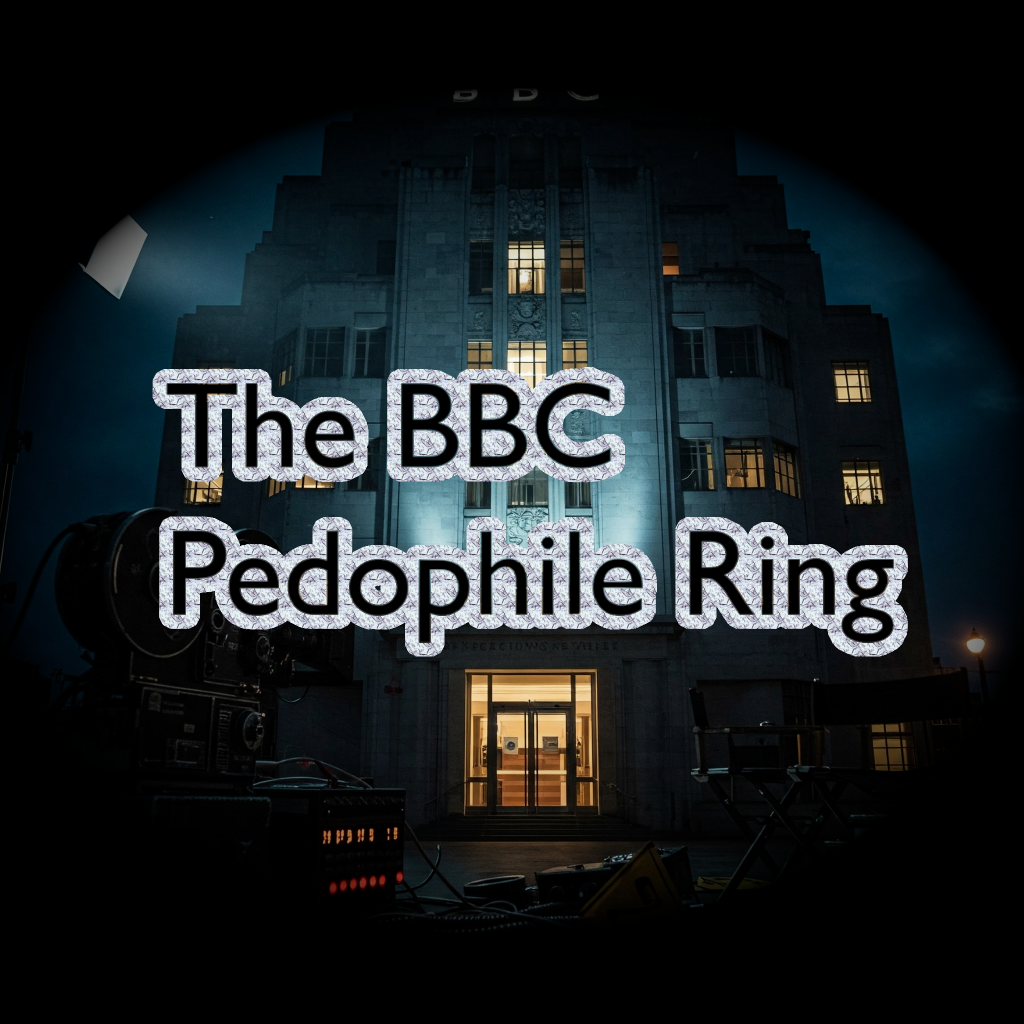A shocking investigation into one of history’s most brazen institutional cover-ups
PART I: THE FACADE CRUMBLES
A single bullet to the head. That’s what silenced BBC presenter Jill Dando on her doorstep in 1999. The killer left no trace, the case remains unsolved, and a man wrongfully spent eight years in prison for her murder before being exonerated. But what if her death wasn’t random? What if Dando, host of “Crimewatch,” knew too much about the darkest secret at the heart of Britain’s most trusted institution?
According to colleagues, Dando had been investigating rumors of a pedophile ring operating within the BBC—a network protected at the highest levels. She had gathered evidence, prepared files. And then she was silenced.
For decades, the corridors of BBC’s Broadcasting House concealed monsters hiding behind famous faces, knighthoods, and beloved children’s programs. At the center of this web sat Jimmy Savile—platinum-haired, cigar-chomping, and draped in gaudy jewelry—a predator whose crimes would be revealed only after his comfortable death at age 84 in 2011.
What emerged was not the story of one rogue celebrity, but of an institutional culture that enabled, protected, and possibly participated in the systematic abuse of hundreds of victims—many of them children.
PART II: “HIDING IN PLAIN SIGHT”
On October 3, 2012, nearly a year after Savile’s death, an ITV documentary shattered the carefully constructed mythology around one of Britain’s most recognized television personalities. In “Exposure: The Other Side of Jimmy Savile,” multiple women came forward to describe how Savile had sexually assaulted them as teenagers during the 1960s and 1970s.
The dam broke. Within days, allegations flooded in from across the United Kingdom.
“This is a watershed moment,” declared Commander Peter Spindler as the Metropolitan Police launched Operation Yewtree to investigate. “Savile used his celebrity status, his position in society, to get his sexual gratification.”
By January 2013, investigators had documented a staggering 450 specific allegations against Savile alone, involving victims as young as eight years old. The abuse spanned 54 years—from 1955 to 2009—and occurred not just at BBC studios but at 13 hospitals where Savile volunteered, including secure psychiatric facilities.
At Broadmoor psychiatric hospital, Savile was inexplicably given his own set of keys, a private room, and authority to roam the wards—including female wards—unsupervised. At Stoke Mandeville Hospital, he had his own living quarters. At Leeds General Infirmary, he freely accessed the morgue, where—most disturbing of all—there were allegations of necrophilia.
The BBC’s own investigation revealed that incidents of abuse took place in virtually every BBC premise where Savile worked. He would assault young girls in his dressing room immediately after filming children’s programs. He molested a 13-year-old girl during the final recording of “Top of the Pops” in 2006—when he was 79 years old.
One survivor described being repeatedly raped by Savile in a BBC dressing room at just 15, while production staff stood guard outside. Another recounted being assaulted in Savile’s motor home, which he kept permanently parked in BBC lots and hospital parking areas.
But Savile didn’t operate alone.
PART III: THE NETWORK EMERGES
Operation Yewtree expanded beyond Savile to uncover other predators—some directly connected, others operating independently within the same enabling environment. By 2015, 19 people had been arrested, with seven ultimately convicted.
The network of abusers connected to the BBC reads like a who’s who of 1970s British entertainment:
Gary Glitter (Paul Gadd): The glam rock star who performed on Savile’s shows was convicted of downloading child abuse images in 1999. In 2015, he was sentenced to 16 years for sexual offenses against three girls aged between 8 and 13. Despite this, testimony revealed that BBC managers had invited Glitter to star in “Children in Need” in 1994, a year after he’d been accused of raping a 14-year-old.
Rolf Harris: The Australian-born artist and children’s TV presenter was a staple of BBC programming for decades. Convicted in 2014 of twelve counts of indecent assault against four underage girls between 1968 and 1986, Harris was sentenced to nearly six years in prison. Witnesses reported Savile personally giving Harris a tour of Broadmoor Hospital, timing their visit to coincide with female patients undressing.
Stuart Hall: The presenter of BBC’s “It’s a Knockout” pleaded guilty in 2013 to indecently assaulting 13 girls, the youngest aged just 9. Former BBC employees testified that management knew Hall was luring young girls into his dressing room—he had a special room set aside for this—yet did nothing.
Dave Lee Travis: The BBC Radio 1 DJ and regular presenter on Savile’s “Top of the Pops” was convicted of indecent assault in 2014. Though he claimed to barely know Savile, they worked together for years.
Chris Denning: One of the original BBC Radio 1 DJs, Denning was sentenced to 13 years in prison in 2016 for sexual offenses against 24 boys as young as 9. Some of this abuse allegedly occurred in Savile’s home. Denning would take boys to watch “Top of the Pops” and introduce them to celebrities, including Savile.
Ray Teret: Savile’s chauffeur and former flatmate was sentenced to 25 years for raping and indecently assaulting 17 teenage girls. One offense was committed jointly with Savile.
Jonathan King: The music producer and BBC presenter was jailed for seven years in 2001 for sexually abusing five boys aged 14 and 15. King brazenly continues to defend Savile’s innocence to this day.
The web extended further to include Tam Paton, manager of the Bay City Rollers, who ran his own pedophile ring centered around the Walton Hop disco, which Denning and King also frequented.
PART IV: THE INSTITUTION THAT FAILED
How could such a network operate within Britain’s most prestigious broadcaster for decades?
The BBC launched an independent investigation led by Dame Janet Smith, which found the institution during this period was “a place ripe with discrimination and harassment” with “serious failings in culture and systems.” Despite these findings, the report maintained that senior management remained unaware of Savile’s crimes—a claim contested by numerous former employees.
“Stuart could do what Stuart could do,” one former BBC studio worker said about Hall, suggesting management’s willful blindness. When complaints emerged, they were ignored or suppressed.
Sir Roger Jones, former BBC governor, admitted he had banned Savile from the “Children in Need” charity telethon because he suspected he was “a pretty creepy sort of character”—yet failed to report his concerns to senior management.
When producer Meirion Jones discovered Savile had been taking girls from the Duncroft approved school for troubled teenagers in his Rolls-Royce in the 1970s, the BBC refused to air his investigation.
Even more disturbing was the BBC’s hiring practices. The corporation admitted that approximately 1,500 workers had been hired off the books, allowing them to obscure who was actually working with their stars and in their buildings.
PART V: SUSPICIOUS DEATHS AND SILENCED WITNESSES
The Dando murder isn’t the only suspicious death connected to this case.
David Smith, a former driver for Savile and other BBC celebrities, was found dead in an apparent suicide in 2013—the day he was due to stand trial for sexually abusing a 12-year-old boy in 1984. Smith had previously been convicted of 22 offenses against young boys in 1966.
Smith had worked for a private chauffeur company used by the Australian High Commission, which employed multiple convicted pedophiles. Witnesses testified that he would pick up young boys from care homes and deliver them to organized pedophile gatherings in upscale London neighborhoods.
When allegations about Smith emerged, the BBC immediately distanced itself, claiming he had never worked for them—though they later admitted he had been hired through a third-party company.
Two of Smith’s victims, Jason Little and Lee Sullivan, came forward to describe how Smith had taken them to parties, drugged them, and allowed them to be abused by multiple men. But with Smith’s death, crucial testimony about these networks died with him.
PART VI: THE AFTERMATH AND QUESTIONS THAT REMAIN
Operation Yewtree triggered a national reckoning and spawned additional investigations. Operation Hydrant was established in 2014 to coordinate inquiries into historical child abuse, eventually investigating over 1,400 suspects—including 261 public figures and 135 from TV, film, or radio.
The scandal exposed deep institutional failures not just at the BBC but across British society. The National Health Service, the Crown Prosecution Service, and various children’s homes all failed to protect vulnerable individuals from predators who exploited their positions of trust.
Despite these revelations, critical questions remain unanswered:
- How many victims never came forward?
- Were higher-level political figures involved in these networks?
- Was Jill Dando’s murder connected to what she knew?
- Did the network extend beyond the handful of perpetrators who were caught?
- Why were so many complaints ignored for decades?
Even now, some institutions continue to resist full transparency. The BBC has never formally acknowledged that an organized pedophile ring operated within its walls, despite the evident connections between multiple convicted abusers who worked there simultaneously.
CONCLUSION: THE MONSTERS WHO WALKED AMONG US
The most chilling aspect of the BBC scandal is how these predators operated in plain sight, using their celebrity to silence critics and victims alike. They didn’t hide in the shadows—they hosted children’s shows, received knighthoods, raised money for children’s charities, and were welcomed into schools and hospitals.
Savile, with his bizarre appearance and mannerisms, used eccentricity as camouflage. “He was hiding in plain sight,” as the police report put it. His signature catchphrase—”Jim’ll fix it”—takes on a sinister double meaning in retrospect, suggesting not just his show’s premise of granting children’s wishes, but his ability to manipulate systems and people to enable his crimes.
For the hundreds of victims, many of whom spent decades suffering in silence, the revelations brought validation but little justice. Most of the perpetrators either died before exposure or received sentences that seemed woefully inadequate compared to the scale and impact of their crimes.
Perhaps the most disturbing legacy of this case is the question it forces us to confront: How many other powerful abusers continue to operate with impunity, protected by institutions more concerned with reputation than accountability?
The monsters of Broadcasting House remind us that predators don’t always lurk in shadows. Sometimes they smile at us from our television screens, knighted by queens and blessed by popes, while building a legacy of trauma that reverberates across generations.
HighKeySus.com is dedicated to documented cases and evidence-based research. This article is based on official investigations, court records, and testimony from survivors.


Great article! Cant wait to read more…